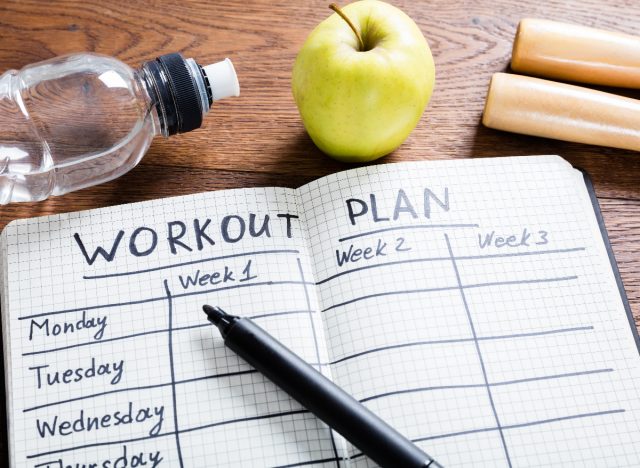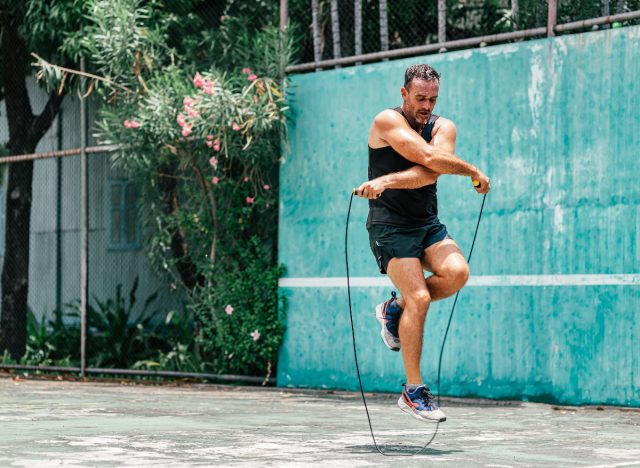If there’s one aspect of physical fitness and vitality that begins to dwindle noticeably with age, it’s stamina. However, with the right approach and a few simple adjustments to your daily routine, you can regain and even increase your stamina and endurance. Also, we have excellent news: Incorporating the following habits into your lifestyle can significantly impact your overall fitness and well-being to further boost your stamina and endurance.
From incorporating regular exercise to making mindful choices about your nutrition and sleep, these habits cover a range of areas that contribute to your stamina. Here, you’ll discover practical tips and strategies to help you enhance your cardiovascular fitness, increase energy levels, and overcome fatigue.
Jarrod Nobbe, CPT, a certified personal trainer with Garage Gym Reviews, tells Eat This, Not That!, “Building stamina is a common goal in fitness, but it’s not easy to achieve. It takes consistency and time, but there’s a lot you can do to speed up your progress.”
It’s always possible to prioritize your health and fitness. So whether you’re already in your 40s or approaching this milestone, there’s no better time to invest in boosting your stamina. Read on for Nobbe’s nine daily habits to increase stamina, and prepare to embark on a journey toward a stronger, more resilient you. And when you’re done, check out these 8 Habits That Destroy Your Workout Before You Begin.


“To build stamina at any age, you must train your cardiovascular system,” states Nobbe. “Whether it’s jogging, cycling, swimming, or one of the many other forms of cardiovascular exercise, make sure you include cardio in your routine if your goal is endurance.”
Cardiovascular exercise is essential for building stamina—especially as you age. Regular cardiovascular exercise can help improve your heart and lung health, boost endurance, and increase stamina. Aim for at least 150 minutes of moderate-intensity cardio each week to reap the benefits, as per the Physical Activity Guidelines for Americans.


Consistency is crucial when it comes to building stamina. Make it a habit to engage in regular physical activity, and stick to your workout routine (even when you don’t feel like it). Consistent effort will help your body adapt and improve stamina and endurance.
“Consistency is key, and that especially goes for fitness goals. In your 40s and beyond, keeping a solid, appropriately intense workout and rest schedule that you can stick to is the best way to work toward the goal of endurance,” says Nobbe.


While allowing your body to recover is essential, a 2015 study found that keeping rest periods short during your workouts can help increase your stamina. In addition, reducing the rest time between sets will challenge your cardiovascular system, promoting endurance and stamina development.
“During strength training sessions, you can gear your workouts toward building endurance with longer work periods than rest periods between exercises and sets. This creates a similar effect to cardio as you get your resistance training in,” explains Nobbe.


“Interval training, especially high-intensity (HIIT), has become a popular workout option in recent years,” states Nobbe. “This is because HIIT workouts burn lots of calories in relatively little time. However, another perk of HIIT is that it’s effective at taxing your muscles and cardiovascular system to help build stamina over time.”
Interval training involves alternating between high-intensity bursts of exercise and periods of active recovery. According to research, this method improves cardiovascular fitness and enhances stamina and metabolic efficiency.
READ RELATED: 8 Best Barbecue Chains in America


When building stamina, the safest approach is gradually increasing the duration and intensity of your workouts. Over time, your body will adapt to the increased demands, leading to improved stamina and endurance.
“This is an important aspect of building endurance. Focus on gradually lengthening your workouts rather than going from your typical workout one day to much longer workouts the next,” says Nobbe. “It takes time and patience to build stamina, and you may have to remind yourself daily to keep your eyes on the prize.”


“Food is fuel, and you can’t make progress in your workouts if you don’t put the effort in with nutrition,” says Nobbe. “This is especially true for endurance exercises such as running, where you must ensure you eat well and stay hydrated to get the most out of your training and keep your muscles fueled.”
For optimal stamina gains, fuel your body with nutrient-dense foods, including lean proteins, whole grains, legumes, fruits, and vegetables. In addition, stay hydrated by drinking plenty of water, and avoid excessive intake of sugary and processed foods, which research shows can cause energy crashes.


A strong core is essential for maintaining good posture, stability, and overall strength, says a 2018 study. So incorporate exercises that target your core muscles, such as planks, Russian twists, or bicycle crunches, into your routine.
“A strong core is the basis of good form in virtually any exercise or movement you do, and posture is often one of the first things to fail during long workouts or endurance exercise,” explains Nobbe. “Working your core daily doesn’t mean targeting it with exercise daily, but you should always be conscious of your posture and keep a strong core and neutral spine throughout your day.”


Monitoring your heart rate during workouts can provide valuable insights into your stamina and cardiovascular fitness. “Targeting a heart rate range that fits your age and fitness goals, and then tracking your heart rate while you train, can help you stick to the intensity you’re aiming for and stay safe during workouts. In addition, if you wear a fitness tracker around the clock, you’ll also see positive changes in your resting heart rate if you stick to endurance training,” says Nobbe.


One of the best things you can do to boost your overall health is to prioritize quality sleep, says the Sleep Foundation. Establish a relaxing bedtime routine, create a comfortable sleep environment, and limit exposure to electronic devices before bed.
“It may seem counterintuitive, but rest is where progress is made,” states Nobbe. “If you don’t give your muscles enough time to recover and repair themselves after workouts, you could lose strength and stamina or feel fatigued due to overtraining. Poor sleep is also a progress killer, so prioritize shut-eye daily to stay on track.”










